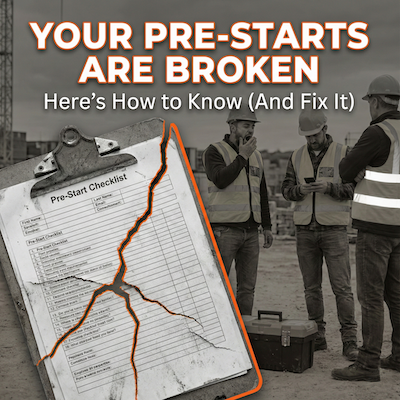A Moment of Hesitation, a Lifetime of Regret
"I stepped out of that job site that day, and I thought... I just about said something to him and I didn't."
These words from Mike Frick, a veteran of the construction and mining industries, hit me like a tonne of bricks during our recent podcast conversation. Mike was describing the moment before a worker fell from scaffolding on his job site, resulting in a broken hip that ended the man's construction career.
It's that split-second decision—to speak up or stay silent—that haunts many of us in high-risk industries. The words never said. The intervention never made. The accident that might have been prevented.
Mike's story isn't just about one incident. It's about the universal human tendency to hesitate when we see something unsafe, and the profound consequences that can follow.
The Heavy Cost of Silence
The worker who fell that day survived, but his life was forever altered. As Mike explained:
"He busted his hip. He will never work construction again. Luckily for him, he had a backup plan, which was being a teacher... but going to the hospital and seeing him down and out because he knows he's crippled for life, and his wife is there and you've got to deal with that."
This scenario plays out across worksites worldwide daily. According to research on psychological barriers to speaking up, our natural hesitation to intervene has multiple roots—from fear of negative judgment to uncertainty about our own observations.
Why We Don't Speak Up: The Psychology of Silence
Research reveals several powerful psychological barriers that prevent us from voicing safety concerns:
Fear of Negative Judgment
Many of us worry about how we'll be perceived if we raise an issue. Will we look incompetent? Overly cautious? A troublemaker? This fear is especially potent in construction and manufacturing environments where toughness is often prized over caution.
Self-Doubt and Confidence Issues
It's common to question our own observations: "Maybe it's not as dangerous as I think." "Perhaps they know something I don't." This self-doubt can be paralyzing, especially for less experienced workers.
Conflict Avoidance
Many people naturally avoid confrontation. Speaking up about safety can feel like creating conflict, especially if the person engaging in unsafe behaviour is a superior or experienced colleague.
The Bystander Effect
Perhaps most insidious is the "bystander effect"—where we assume someone else will take responsibility. In environments with multiple workers, the likelihood of anyone speaking up actually decreases as more people are present.
The Moment That Changes Everything
For Mike, witnessing the consequences of his silence became a turning point:
"That was my lesson learned—I always say something. Guys might get tired of me saying it. I might think that they get tired of me saying it. But at least I'm going to say it. I don't care how corny it sounds or how bad they may not like it. I'm going to say it."
This transformation—from bystander to active safety advocate—represents the journey many of us need to make.
Listen to the full conversation with Mike Frick:
Creating a Culture Where Speaking Up Is the Norm
What makes some workplaces conducive to speaking up while others foster silence? Research on intervention psychology points to several key factors:
Autonomy Support
Environments where workers feel their input is genuinely valued foster more speaking up. When leaders ask, "What do you think about this approach?" rather than dictating compliance, they create psychological safety.
Competence Building
Workers who receive training in how to effectively raise concerns are 73% more likely to intervene when they observe risks. This includes practice with specific language and techniques for non-confrontational intervention.
Strong Relationships
Teams with strong interpersonal connections demonstrate significantly faster response times to safety issues. When workers view their colleagues as "family," they're more motivated to protect each other.
Practical Strategies: The 3D Framework for Intervention
Contemporary bystander intervention training uses the "3D" framework—Delegate, Distract, Direct—to provide multiple pathways for speaking up:
- Delegate: Find the appropriate person to help address the situation
- Distract: Use creative, non-confrontational methods to interrupt unsafe situations
- Direct: Clearly and respectfully communicate the concern
For Mike, the direct approach has become his standard: "I'm going to say it." But having multiple strategies increases the likelihood that someone will find a comfortable way to intervene.

Leadership's Critical Role
Leaders set the tone for whether speaking up is rewarded or punished. Research shows that when executives participate in the same safety simulations as frontline workers, intervention rates increase by 29%.
Mike's experience supervising 45 workers on a major project for Kiewit (one of America's largest construction companies) revealed a striking correlation: The sites with the highest safety performance also had the highest profit margins.
"While I was doing the zero accidents and incidences, my profit margin was the highest in the company at the same time," Mike explained. His secret? Making genuine connections with workers:
"I make sure that they know that I care for them... Once they know that you care for them, they'll do anything in the world for you as far as they can."
From Tragedy to Transformation
Mike's story reminds us that sometimes the most powerful safety tools aren't checklists or procedures, but human connection and the courage to speak.
The regret of "the words I never said" transformed Mike into someone who will always say something, regardless of how it might be received. His experience teaches us that silence has consequences, but so does speaking up—and the latter saves lives.
Whether you're a frontline worker, supervisor, or executive, remember that your voice matters. That observation you're hesitating to share could be the difference between someone going home safely or not going home at all.
As Mike puts it, with the wisdom of someone who's lived with both silence and speaking up: "I always say something."
What about you?

Take Action Today:
- What's one specific situation where you've hesitated to speak up about safety?
- Which of the 3D strategies (Delegate, Distract, Direct) would feel most comfortable for you?
- How can you help create an environment where others feel safe to speak up?
Share your thoughts in the comments below.










.svg)
